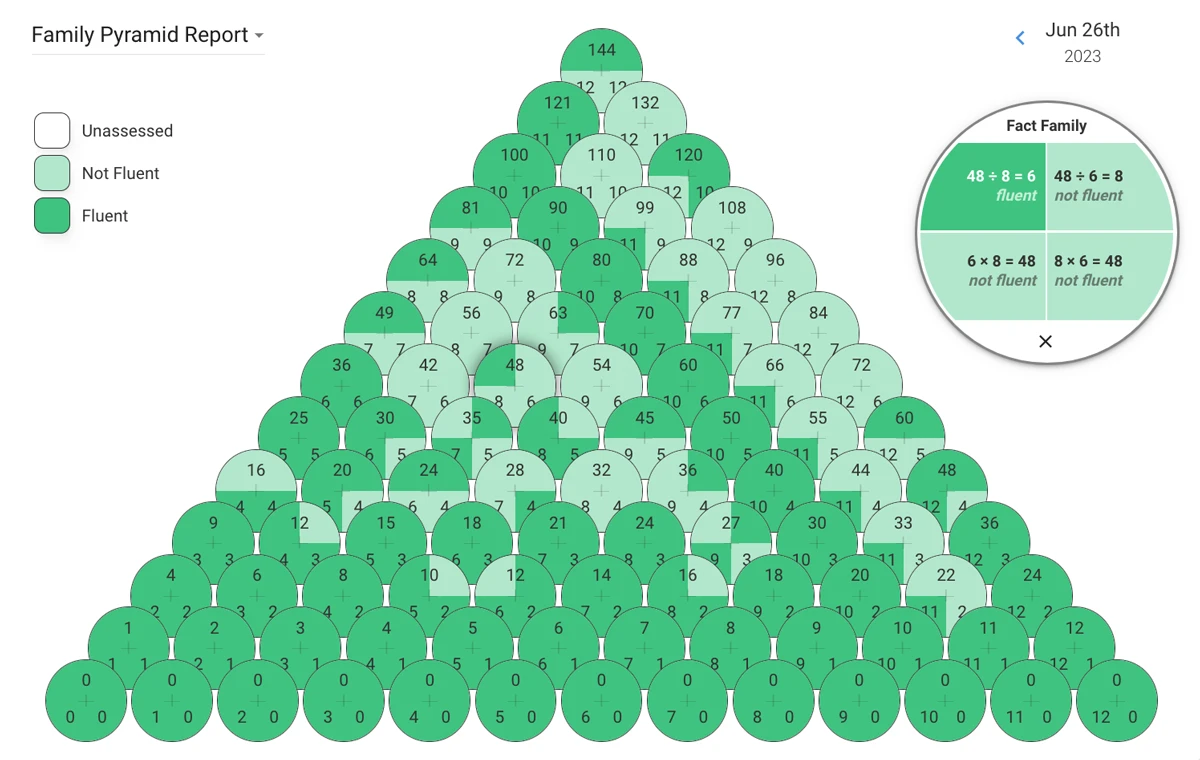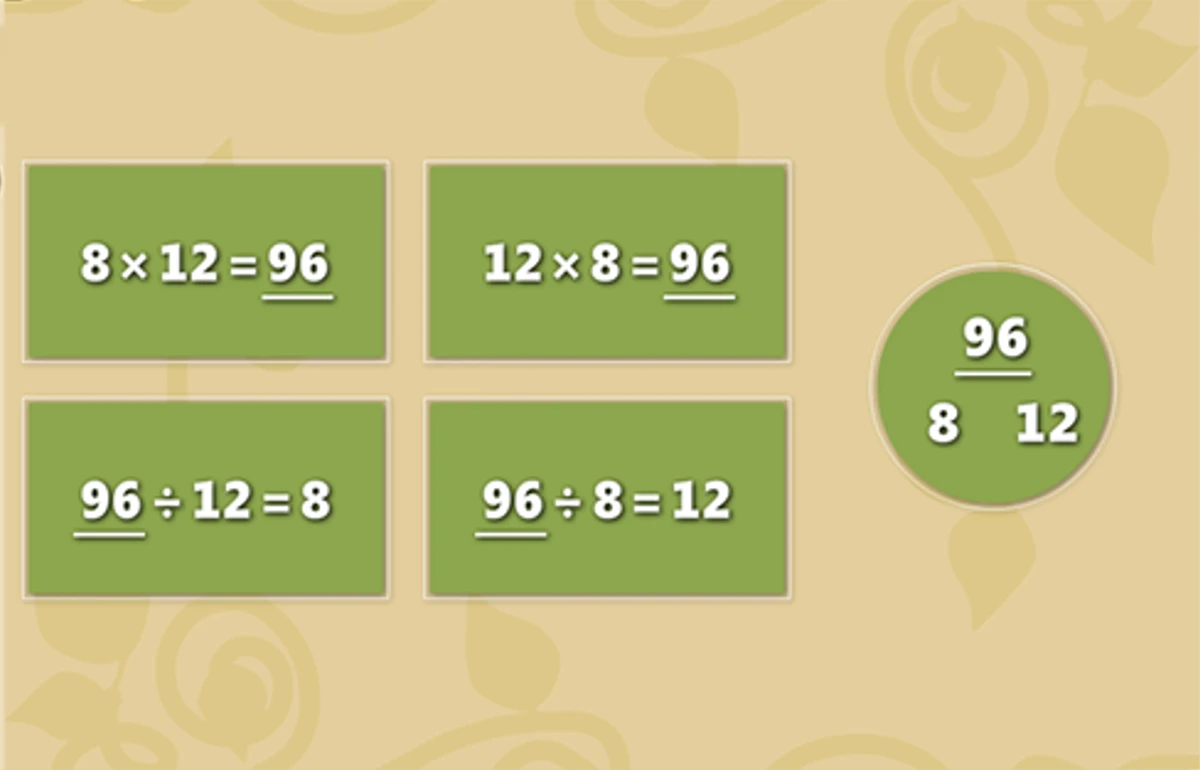Fact Family in Math: What Is It and Why Does it Matter?
.webp?w=815&quality=80&format=webp)
Young math students often struggle with math facts, which are strong indicators of future success in math. Math fact fluency is foundational to learning math and significantly predicts student math performance. They uniquely affect students’ standardized test scores and college-prep math and career coursework participation.
It may sound overwhelming that math facts have such tremendous impacts. There’s good news, though. Reflex prepares students for success with math fact fluency by using a math fact family approach. What is a fact family?
Breaking down the basics: What are fact families in math?
Reflex uses a fact family approach for teaching new facts because it works. In math, a fact family is a group of related facts that use the same numbers. There are addition and subtraction fact families and multiplication and division fact families.
What does fact family mean in math? A fact family is a set of related math facts using the same three numbers. Fact families highlight the inverse relationship between addition and subtraction (or multiplication and division). These families use the same three numbers to form equations.
Examples of fact families
What is a family of facts? To better understand the idea, take a look at these fact family examples. The numbers 3, 5, and 8 form a fact family with the following addition and subtraction equations: 5 + 3 = 8, 3 + 5 = 8, 8 - 3 = 5, and 8 - 5 = 3. Similarly, for multiplication and division, the numbers 6, 8, and 48 can form a fact family: 6 x 8 = 48, 8 x 6 = 48, 48 / 6 = 8, and 48 / 8 = 6. Fact families involving doubles, such as 5 + 5 = 25, have only two facts.

Understanding the intricacies of fact families
Learning related math facts (or fact families) together is ultimately easier and more efficient. Instead of teaching facts for addition and subtraction or multiplication and division separately, consider how they relate to one another. If 8 x 12 = 96, then it must also be true that 96 ÷ 8 = 12.

This method provides a less intimidating way to think about learning facts. There are fewer fact families to learn as opposed to separate multiplication or division facts, for example. It also helps students understand the nature of inverse operations.
How can fact families improve math fact fluency?
Understanding fact families is vital in building mathematical proficiency and preparing students for more complex math. Strategies that provide number sense, such as introducing small sets of new facts with strategies like fact families math, are a part of fluency development.
Teaching fact families also helps students develop automaticity, a vital building block for future math success. Students who develop automaticity quickly and efficiently recall answers without conscious thought, freeing up their working memory. This makes it easier for students to focus on problem-solving and learning new concepts and skills.
While some math programs only work with memorization, Reflex understands that automaticity needs to pair with math fact fluency. A conceptual understanding of the operations serves as a prerequisite to building automaticity. Reflex helps students achieve math fact fluency and automaticity through a fact family approach with individualized coaching, practice, and assessment delivered via a fun, game-based approach.
How to teach fact families to students
When students understand fact families, they also understand the relationship between the numbers in a family. They can take that knowledge a step further and apply that relationship to solving new problems. The student who knows that 6 x 7 = 42 also knows that 42 ÷ 6 = 7. This understanding empowers students to move efficiently and effectively through related addition, subtraction, multiplication, or division problems.
How can teachers help students gain this kind of understanding? There’s a variety of ideas. To teach fact families, try:
- Concrete manipulatives
- Visual representations like diagrams or triangles
- Games and activities for interactive learning
- Verbal explanations and discussions
How Reflex teaches math fact families
The Reflex system is based on a fact family approach that builds on and reinforces critical mathematical concepts such as the commutative property and the relationship between the operations. Reflex uses a variety of explicit strategies to teach new facts, including the commutative property, fact families, and rule-based patterns, such as multiplication by ten. Students receive introductory lessons on these strategies, then Reflex uses these strategies to build on the students’ existing fluency in an explicit manner. For example, a student may have some fluency with 3 x 6 but be inconsistent with 6 x 3. Reflex will leverage this existing ability and support the student in making the connection between the known and unknown facts using the commutative property. In future sessions, Reflex extends this approach to fact families by identifying a family with which the student has some pre-existing ability to build on the student’s knowledge by connecting it to the related facts.
Reflex benefits students of all ages who need to strengthen their foundational math skills by focusing on developing automaticity across four key operations: addition, subtraction, multiplication, and division. Students can accelerate their progress to automaticity when they make conceptual connections between facts.
Adaptive coaching from Coach Penny that focuses on fact families and commutative property is one example of the Reflex approach that helps students succeed. Reflex also allows teachers and students to access data and track fact family progress. The Fact Detail report shows which facts a student knows and doesn’t know. This report is available in both a fact family pyramid and a traditional “fact grid” format. If you click a fact family, a window will pop up to show you exactly which facts are fluent, not fluent, or unassessed.
Students can also access this report by clicking their Student Avatar image and selecting the Report Icon (four white squares). They can use the information to set personal goals and build confidence.
“I have one student with a personal goal to grow her confidence in math. One way that she chose to do this was by becoming math fact fluent in Reflex. Now I see her apply those fact families as she works with fractions, and she beams as she completes her math assignments!”
- Reflex Teacher, International School of Panama, Panama
Enhance math facts and fact family learning with Reflex
Throughout a student’s first few sessions, Reflex learns whether or not students have achieved fluency with specific facts and families. It uses this information when making instructional decisions to adapt for each student and continually monitors student progress. This means that students won’t spend time learning facts that they already know.
With Reflex, students build speed and accuracy with math fact families. Every student practices the right facts at the right time, and lessons are based on the retention of previous lessons. New facts are always presented as fact families, which helps students view them as one related set of numbers rather than four separate facts to learn.
Reflex delivers measurable results with a fact family and commutative property approach that can significantly impact success with mathematical procedures and concepts at any grade level.
Reflex supports accelerated growth and achievement of grade-level standards
There’s a reason why Reflex is considered to be the most effective and flexible math fact fluency system available. With plenty of research to back up that claim, Reflex simply stands out. Across multiple grade levels, standardized tests, and benchmark assessments, students who use Reflex score higher and grow faster than their peers, as demonstrated by numerous independent, academic efficacy studies.
In recent studies, Reflex users were 2x more likely to meet ambitious math growth goals compared to non-users. Reflex use was also equated to significant fluency gains. Throughout all schools with high Reflex usage in another study, students experienced large fluency gains, with an average starting fluency of 20.4% (start of grade 3) to an average ending fluency of 84.8% (end of grade 5).
Of course, teachers choose Reflex for math fact fluency because of the proven results. There’s more! According to a survey, teachers count on Reflex to:
- Improve students’ math fact fluency and automaticity
- Maintain student interest and motivation
- Make math fun and engaging for students
- Track student progress and see tangible fluency results with data
Are you ready for a math resource you can count on to deliver results, too? Take a free trial, and see the difference Reflex can make with your students.
